Analysis of E-waste Management Policies and Impacts in China
VerifiedAdded on 2022/08/14
|55
|14527
|10
Report
AI Summary
This report examines the critical issue of e-waste management in China, with a specific focus on the Guiyu region, a major e-waste recycling site. It explores the environmental and health consequences of e-waste, including soil and water contamination, and the impact on human health, such as lead poisoning in children. The report analyzes the policies implemented in China and other countries, like Malaysia, to control e-waste accumulation and promote recycling. It investigates the impact of these policies on environmental, health, social, and financial factors. The study highlights the historical context, the challenges faced by e-waste workers, and the effectiveness of various management strategies. The research includes a literature review, methodology, data analysis, and a discussion of findings, culminating in conclusions and recommendations for improved e-waste management practices.
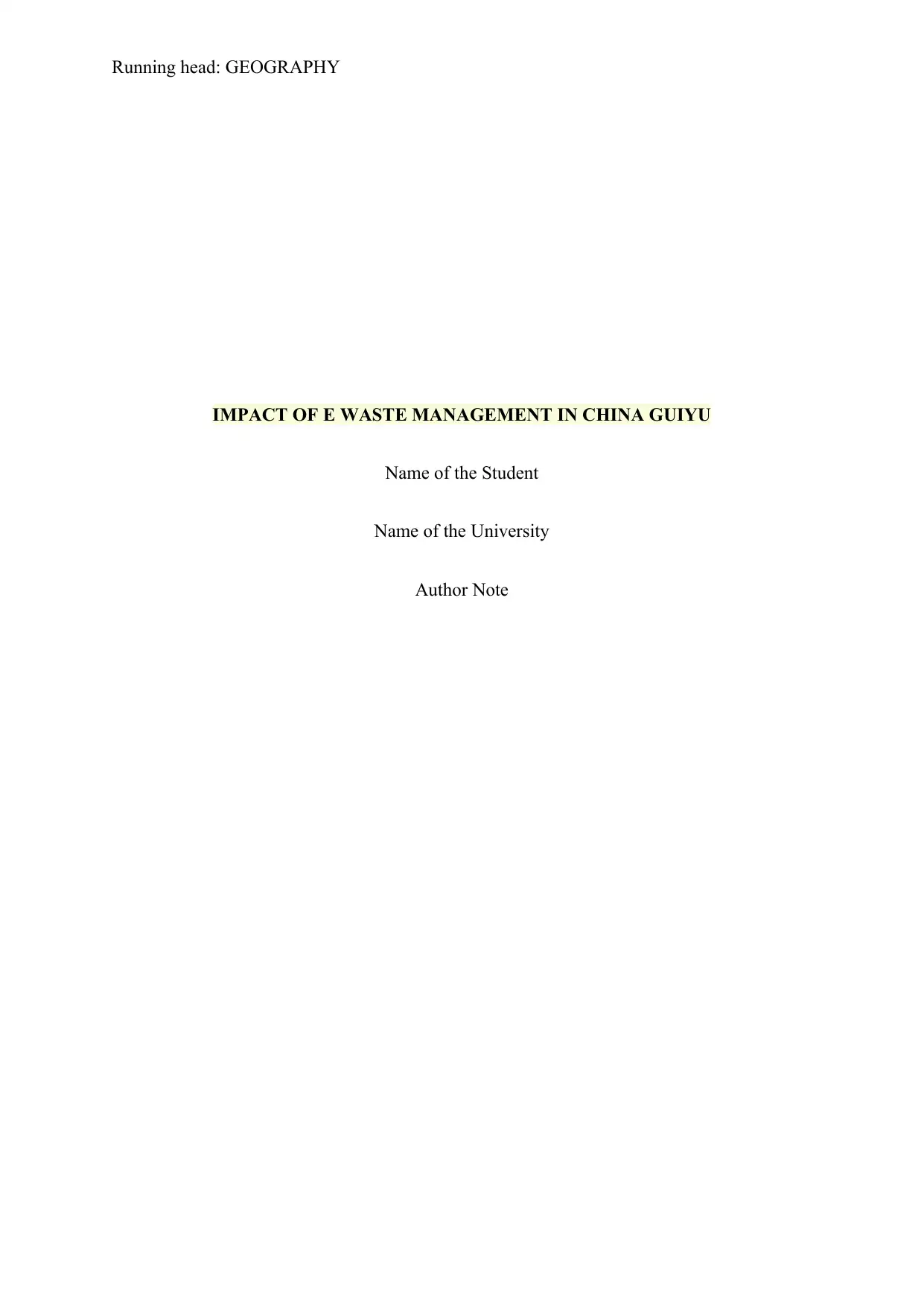
Running head: GEOGRAPHY
IMPACT OF E WASTE MANAGEMENT IN CHINA GUIYU
Name of the Student
Name of the University
Author Note
IMPACT OF E WASTE MANAGEMENT IN CHINA GUIYU
Name of the Student
Name of the University
Author Note
Paraphrase This Document
Need a fresh take? Get an instant paraphrase of this document with our AI Paraphraser
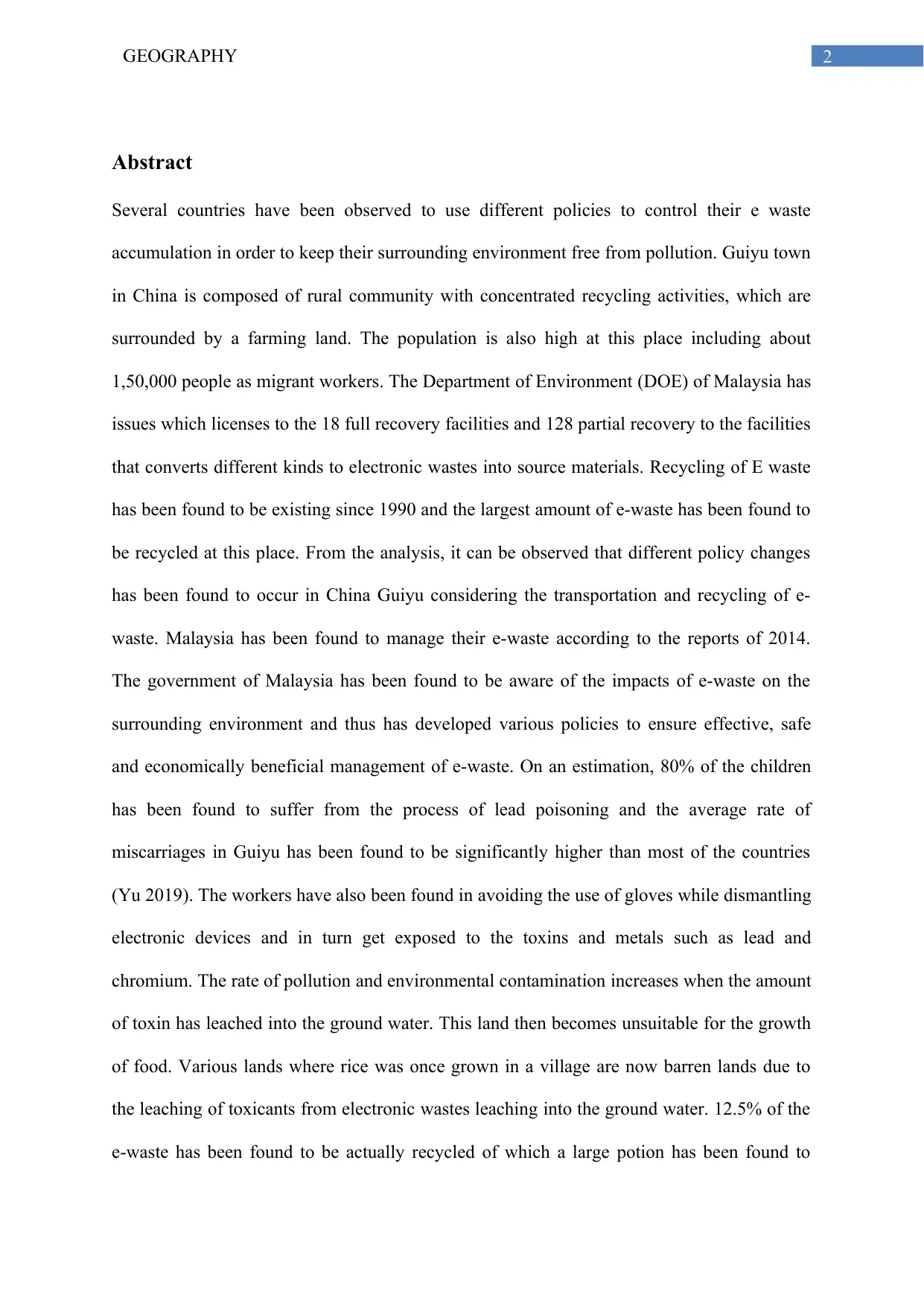
2GEOGRAPHY
Abstract
Several countries have been observed to use different policies to control their e waste
accumulation in order to keep their surrounding environment free from pollution. Guiyu town
in China is composed of rural community with concentrated recycling activities, which are
surrounded by a farming land. The population is also high at this place including about
1,50,000 people as migrant workers. The Department of Environment (DOE) of Malaysia has
issues which licenses to the 18 full recovery facilities and 128 partial recovery to the facilities
that converts different kinds to electronic wastes into source materials. Recycling of E waste
has been found to be existing since 1990 and the largest amount of e-waste has been found to
be recycled at this place. From the analysis, it can be observed that different policy changes
has been found to occur in China Guiyu considering the transportation and recycling of e-
waste. Malaysia has been found to manage their e-waste according to the reports of 2014.
The government of Malaysia has been found to be aware of the impacts of e-waste on the
surrounding environment and thus has developed various policies to ensure effective, safe
and economically beneficial management of e-waste. On an estimation, 80% of the children
has been found to suffer from the process of lead poisoning and the average rate of
miscarriages in Guiyu has been found to be significantly higher than most of the countries
(Yu 2019). The workers have also been found in avoiding the use of gloves while dismantling
electronic devices and in turn get exposed to the toxins and metals such as lead and
chromium. The rate of pollution and environmental contamination increases when the amount
of toxin has leached into the ground water. This land then becomes unsuitable for the growth
of food. Various lands where rice was once grown in a village are now barren lands due to
the leaching of toxicants from electronic wastes leaching into the ground water. 12.5% of the
e-waste has been found to be actually recycled of which a large potion has been found to
Abstract
Several countries have been observed to use different policies to control their e waste
accumulation in order to keep their surrounding environment free from pollution. Guiyu town
in China is composed of rural community with concentrated recycling activities, which are
surrounded by a farming land. The population is also high at this place including about
1,50,000 people as migrant workers. The Department of Environment (DOE) of Malaysia has
issues which licenses to the 18 full recovery facilities and 128 partial recovery to the facilities
that converts different kinds to electronic wastes into source materials. Recycling of E waste
has been found to be existing since 1990 and the largest amount of e-waste has been found to
be recycled at this place. From the analysis, it can be observed that different policy changes
has been found to occur in China Guiyu considering the transportation and recycling of e-
waste. Malaysia has been found to manage their e-waste according to the reports of 2014.
The government of Malaysia has been found to be aware of the impacts of e-waste on the
surrounding environment and thus has developed various policies to ensure effective, safe
and economically beneficial management of e-waste. On an estimation, 80% of the children
has been found to suffer from the process of lead poisoning and the average rate of
miscarriages in Guiyu has been found to be significantly higher than most of the countries
(Yu 2019). The workers have also been found in avoiding the use of gloves while dismantling
electronic devices and in turn get exposed to the toxins and metals such as lead and
chromium. The rate of pollution and environmental contamination increases when the amount
of toxin has leached into the ground water. This land then becomes unsuitable for the growth
of food. Various lands where rice was once grown in a village are now barren lands due to
the leaching of toxicants from electronic wastes leaching into the ground water. 12.5% of the
e-waste has been found to be actually recycled of which a large potion has been found to
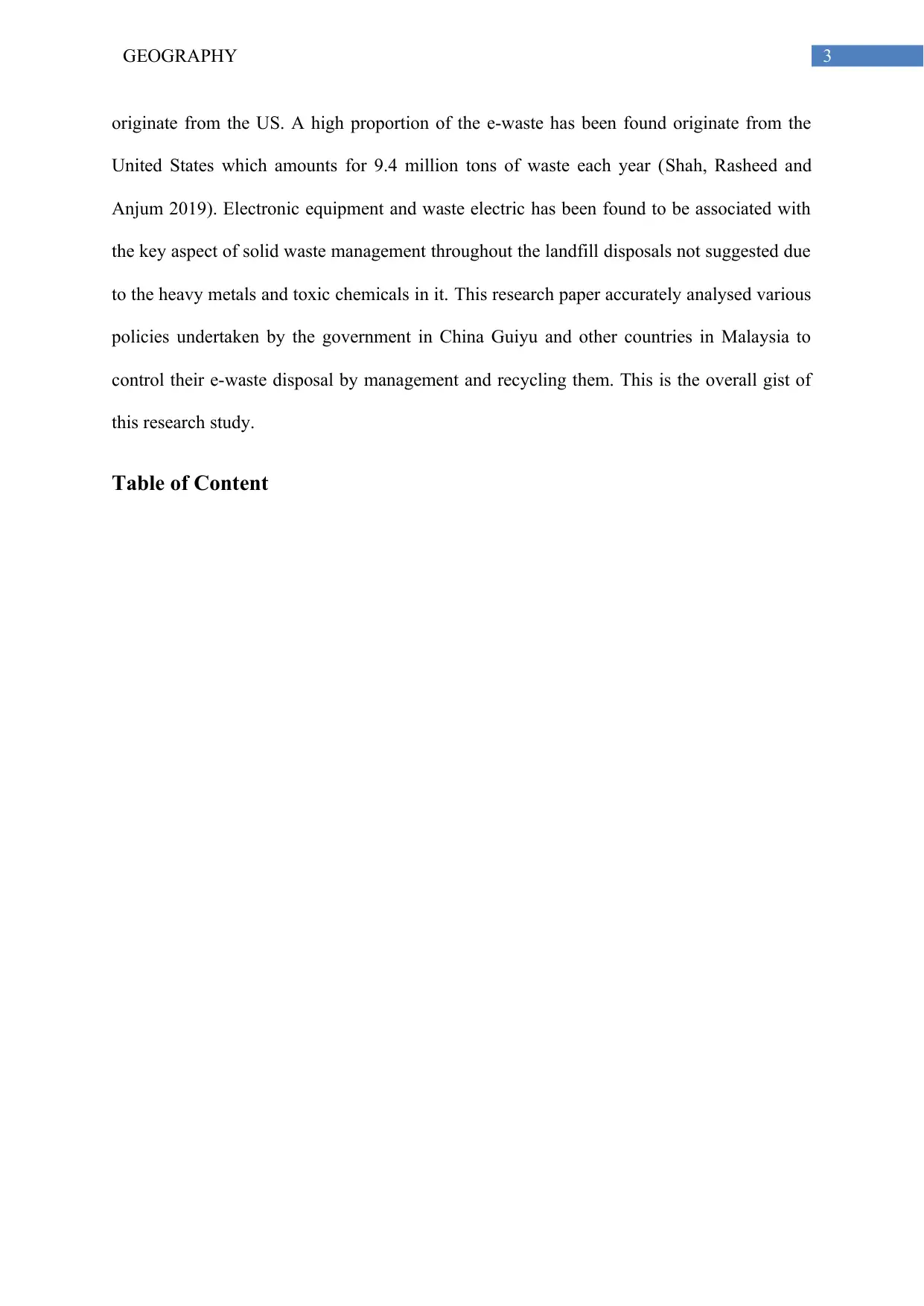
3GEOGRAPHY
originate from the US. A high proportion of the e-waste has been found originate from the
United States which amounts for 9.4 million tons of waste each year (Shah, Rasheed and
Anjum 2019). Electronic equipment and waste electric has been found to be associated with
the key aspect of solid waste management throughout the landfill disposals not suggested due
to the heavy metals and toxic chemicals in it. This research paper accurately analysed various
policies undertaken by the government in China Guiyu and other countries in Malaysia to
control their e-waste disposal by management and recycling them. This is the overall gist of
this research study.
Table of Content
originate from the US. A high proportion of the e-waste has been found originate from the
United States which amounts for 9.4 million tons of waste each year (Shah, Rasheed and
Anjum 2019). Electronic equipment and waste electric has been found to be associated with
the key aspect of solid waste management throughout the landfill disposals not suggested due
to the heavy metals and toxic chemicals in it. This research paper accurately analysed various
policies undertaken by the government in China Guiyu and other countries in Malaysia to
control their e-waste disposal by management and recycling them. This is the overall gist of
this research study.
Table of Content
⊘ This is a preview!⊘
Do you want full access?
Subscribe today to unlock all pages.

Trusted by 1+ million students worldwide
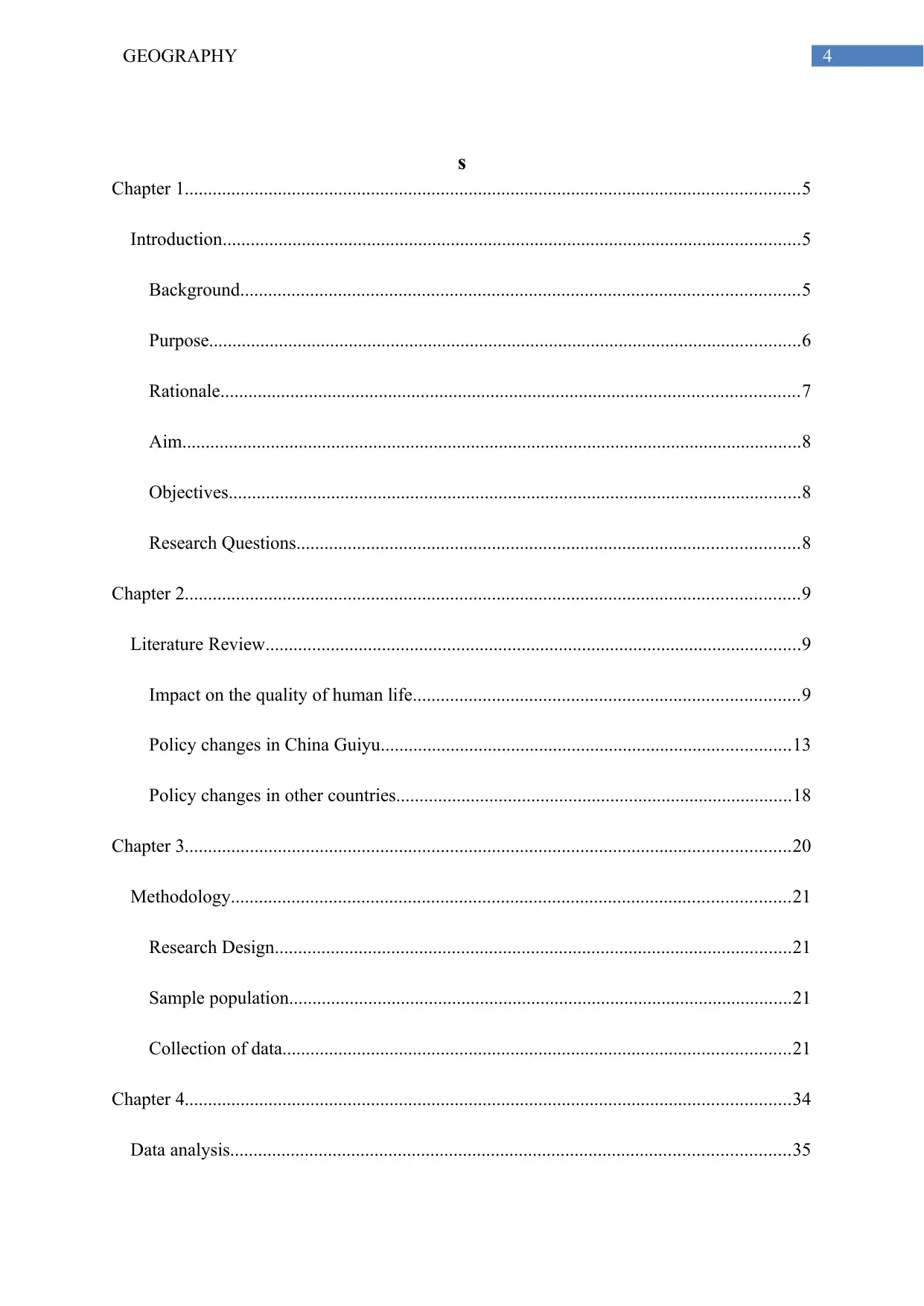
4GEOGRAPHY
s
Chapter 1....................................................................................................................................5
Introduction............................................................................................................................5
Background........................................................................................................................5
Purpose...............................................................................................................................6
Rationale............................................................................................................................7
Aim.....................................................................................................................................8
Objectives...........................................................................................................................8
Research Questions............................................................................................................8
Chapter 2....................................................................................................................................9
Literature Review...................................................................................................................9
Impact on the quality of human life...................................................................................9
Policy changes in China Guiyu........................................................................................13
Policy changes in other countries.....................................................................................18
Chapter 3..................................................................................................................................20
Methodology........................................................................................................................21
Research Design...............................................................................................................21
Sample population............................................................................................................21
Collection of data.............................................................................................................21
Chapter 4..................................................................................................................................34
Data analysis........................................................................................................................35
s
Chapter 1....................................................................................................................................5
Introduction............................................................................................................................5
Background........................................................................................................................5
Purpose...............................................................................................................................6
Rationale............................................................................................................................7
Aim.....................................................................................................................................8
Objectives...........................................................................................................................8
Research Questions............................................................................................................8
Chapter 2....................................................................................................................................9
Literature Review...................................................................................................................9
Impact on the quality of human life...................................................................................9
Policy changes in China Guiyu........................................................................................13
Policy changes in other countries.....................................................................................18
Chapter 3..................................................................................................................................20
Methodology........................................................................................................................21
Research Design...............................................................................................................21
Sample population............................................................................................................21
Collection of data.............................................................................................................21
Chapter 4..................................................................................................................................34
Data analysis........................................................................................................................35
Paraphrase This Document
Need a fresh take? Get an instant paraphrase of this document with our AI Paraphraser
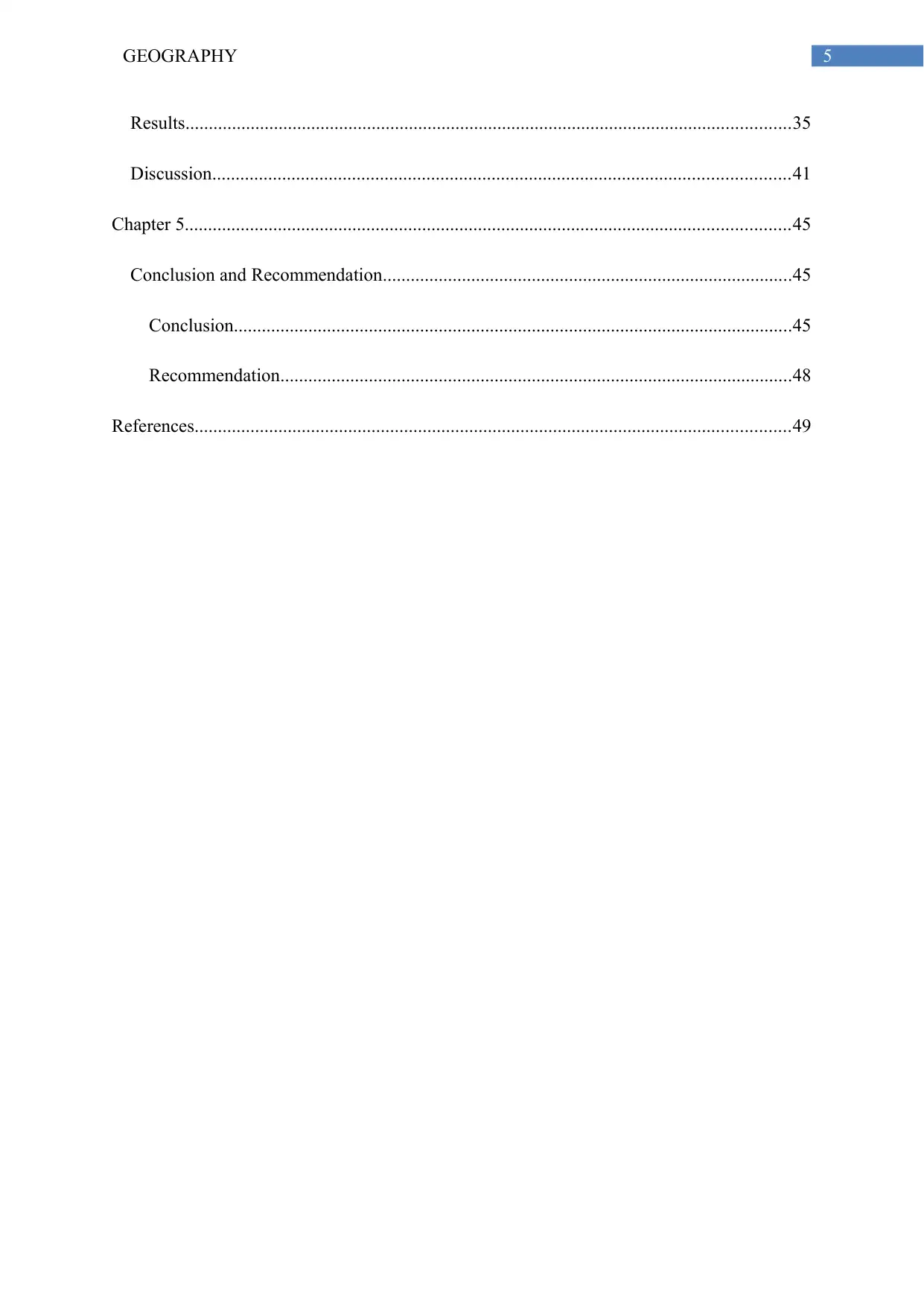
5GEOGRAPHY
Results..................................................................................................................................35
Discussion............................................................................................................................41
Chapter 5..................................................................................................................................45
Conclusion and Recommendation........................................................................................45
Conclusion........................................................................................................................45
Recommendation..............................................................................................................48
References................................................................................................................................49
Results..................................................................................................................................35
Discussion............................................................................................................................41
Chapter 5..................................................................................................................................45
Conclusion and Recommendation........................................................................................45
Conclusion........................................................................................................................45
Recommendation..............................................................................................................48
References................................................................................................................................49
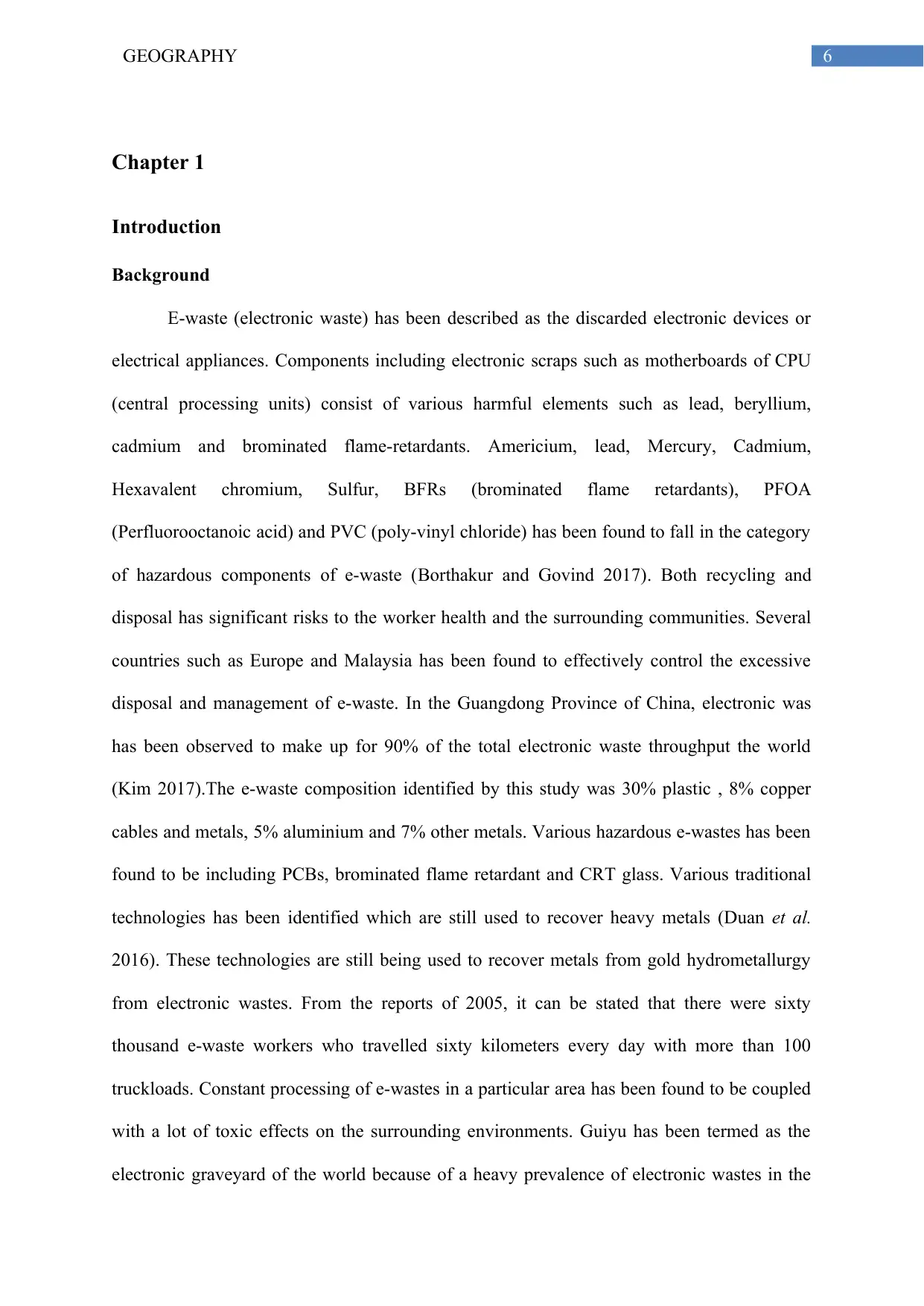
6GEOGRAPHY
Chapter 1
Introduction
Background
E-waste (electronic waste) has been described as the discarded electronic devices or
electrical appliances. Components including electronic scraps such as motherboards of CPU
(central processing units) consist of various harmful elements such as lead, beryllium,
cadmium and brominated flame-retardants. Americium, lead, Mercury, Cadmium,
Hexavalent chromium, Sulfur, BFRs (brominated flame retardants), PFOA
(Perfluorooctanoic acid) and PVC (poly-vinyl chloride) has been found to fall in the category
of hazardous components of e-waste (Borthakur and Govind 2017). Both recycling and
disposal has significant risks to the worker health and the surrounding communities. Several
countries such as Europe and Malaysia has been found to effectively control the excessive
disposal and management of e-waste. In the Guangdong Province of China, electronic was
has been observed to make up for 90% of the total electronic waste throughput the world
(Kim 2017).The e-waste composition identified by this study was 30% plastic , 8% copper
cables and metals, 5% aluminium and 7% other metals. Various hazardous e-wastes has been
found to be including PCBs, brominated flame retardant and CRT glass. Various traditional
technologies has been identified which are still used to recover heavy metals (Duan et al.
2016). These technologies are still being used to recover metals from gold hydrometallurgy
from electronic wastes. From the reports of 2005, it can be stated that there were sixty
thousand e-waste workers who travelled sixty kilometers every day with more than 100
truckloads. Constant processing of e-wastes in a particular area has been found to be coupled
with a lot of toxic effects on the surrounding environments. Guiyu has been termed as the
electronic graveyard of the world because of a heavy prevalence of electronic wastes in the
Chapter 1
Introduction
Background
E-waste (electronic waste) has been described as the discarded electronic devices or
electrical appliances. Components including electronic scraps such as motherboards of CPU
(central processing units) consist of various harmful elements such as lead, beryllium,
cadmium and brominated flame-retardants. Americium, lead, Mercury, Cadmium,
Hexavalent chromium, Sulfur, BFRs (brominated flame retardants), PFOA
(Perfluorooctanoic acid) and PVC (poly-vinyl chloride) has been found to fall in the category
of hazardous components of e-waste (Borthakur and Govind 2017). Both recycling and
disposal has significant risks to the worker health and the surrounding communities. Several
countries such as Europe and Malaysia has been found to effectively control the excessive
disposal and management of e-waste. In the Guangdong Province of China, electronic was
has been observed to make up for 90% of the total electronic waste throughput the world
(Kim 2017).The e-waste composition identified by this study was 30% plastic , 8% copper
cables and metals, 5% aluminium and 7% other metals. Various hazardous e-wastes has been
found to be including PCBs, brominated flame retardant and CRT glass. Various traditional
technologies has been identified which are still used to recover heavy metals (Duan et al.
2016). These technologies are still being used to recover metals from gold hydrometallurgy
from electronic wastes. From the reports of 2005, it can be stated that there were sixty
thousand e-waste workers who travelled sixty kilometers every day with more than 100
truckloads. Constant processing of e-wastes in a particular area has been found to be coupled
with a lot of toxic effects on the surrounding environments. Guiyu has been termed as the
electronic graveyard of the world because of a heavy prevalence of electronic wastes in the
⊘ This is a preview!⊘
Do you want full access?
Subscribe today to unlock all pages.

Trusted by 1+ million students worldwide
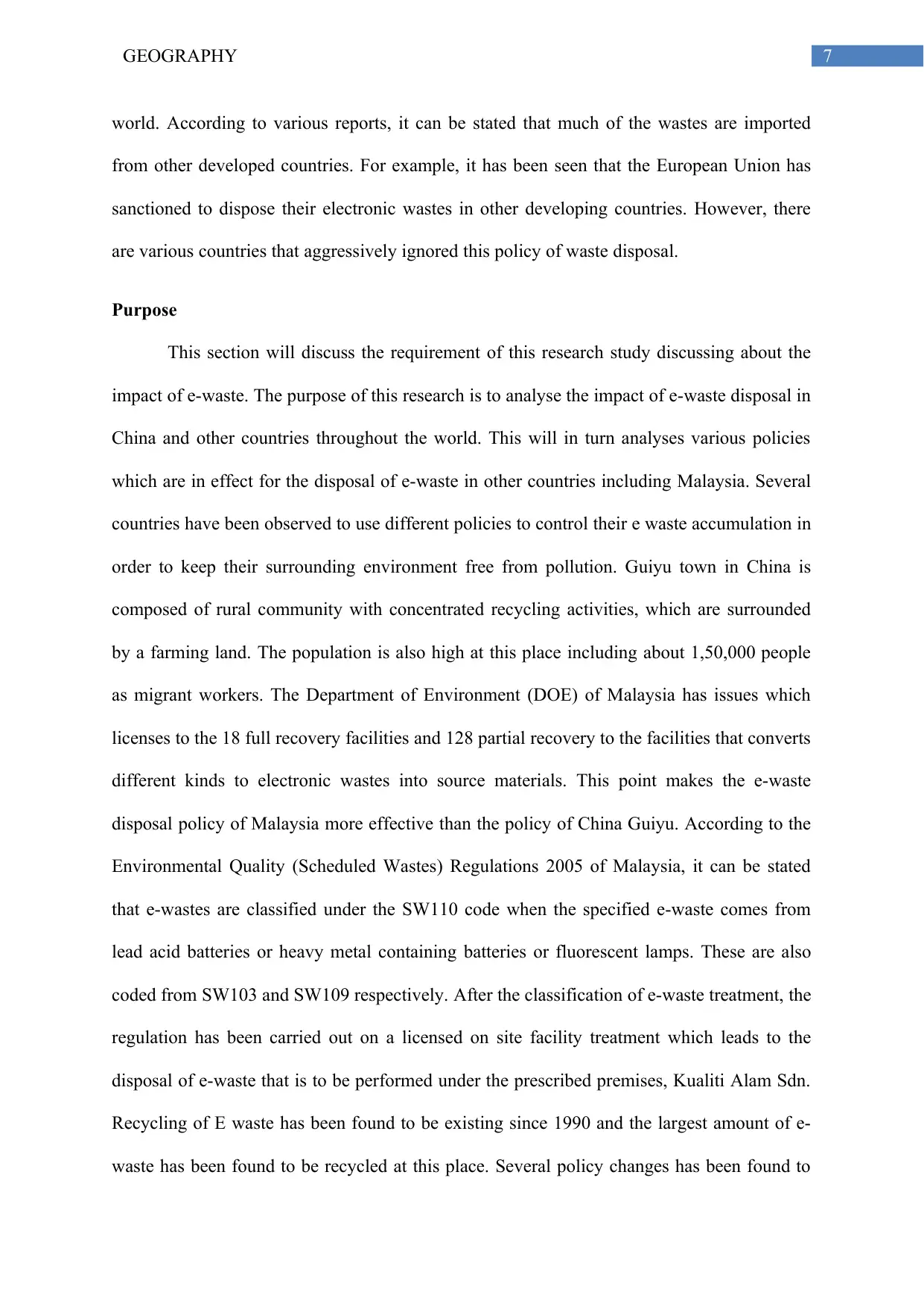
7GEOGRAPHY
world. According to various reports, it can be stated that much of the wastes are imported
from other developed countries. For example, it has been seen that the European Union has
sanctioned to dispose their electronic wastes in other developing countries. However, there
are various countries that aggressively ignored this policy of waste disposal.
Purpose
This section will discuss the requirement of this research study discussing about the
impact of e-waste. The purpose of this research is to analyse the impact of e-waste disposal in
China and other countries throughout the world. This will in turn analyses various policies
which are in effect for the disposal of e-waste in other countries including Malaysia. Several
countries have been observed to use different policies to control their e waste accumulation in
order to keep their surrounding environment free from pollution. Guiyu town in China is
composed of rural community with concentrated recycling activities, which are surrounded
by a farming land. The population is also high at this place including about 1,50,000 people
as migrant workers. The Department of Environment (DOE) of Malaysia has issues which
licenses to the 18 full recovery facilities and 128 partial recovery to the facilities that converts
different kinds to electronic wastes into source materials. This point makes the e-waste
disposal policy of Malaysia more effective than the policy of China Guiyu. According to the
Environmental Quality (Scheduled Wastes) Regulations 2005 of Malaysia, it can be stated
that e-wastes are classified under the SW110 code when the specified e-waste comes from
lead acid batteries or heavy metal containing batteries or fluorescent lamps. These are also
coded from SW103 and SW109 respectively. After the classification of e-waste treatment, the
regulation has been carried out on a licensed on site facility treatment which leads to the
disposal of e-waste that is to be performed under the prescribed premises, Kualiti Alam Sdn.
Recycling of E waste has been found to be existing since 1990 and the largest amount of e-
waste has been found to be recycled at this place. Several policy changes has been found to
world. According to various reports, it can be stated that much of the wastes are imported
from other developed countries. For example, it has been seen that the European Union has
sanctioned to dispose their electronic wastes in other developing countries. However, there
are various countries that aggressively ignored this policy of waste disposal.
Purpose
This section will discuss the requirement of this research study discussing about the
impact of e-waste. The purpose of this research is to analyse the impact of e-waste disposal in
China and other countries throughout the world. This will in turn analyses various policies
which are in effect for the disposal of e-waste in other countries including Malaysia. Several
countries have been observed to use different policies to control their e waste accumulation in
order to keep their surrounding environment free from pollution. Guiyu town in China is
composed of rural community with concentrated recycling activities, which are surrounded
by a farming land. The population is also high at this place including about 1,50,000 people
as migrant workers. The Department of Environment (DOE) of Malaysia has issues which
licenses to the 18 full recovery facilities and 128 partial recovery to the facilities that converts
different kinds to electronic wastes into source materials. This point makes the e-waste
disposal policy of Malaysia more effective than the policy of China Guiyu. According to the
Environmental Quality (Scheduled Wastes) Regulations 2005 of Malaysia, it can be stated
that e-wastes are classified under the SW110 code when the specified e-waste comes from
lead acid batteries or heavy metal containing batteries or fluorescent lamps. These are also
coded from SW103 and SW109 respectively. After the classification of e-waste treatment, the
regulation has been carried out on a licensed on site facility treatment which leads to the
disposal of e-waste that is to be performed under the prescribed premises, Kualiti Alam Sdn.
Recycling of E waste has been found to be existing since 1990 and the largest amount of e-
waste has been found to be recycled at this place. Several policy changes has been found to
Paraphrase This Document
Need a fresh take? Get an instant paraphrase of this document with our AI Paraphraser
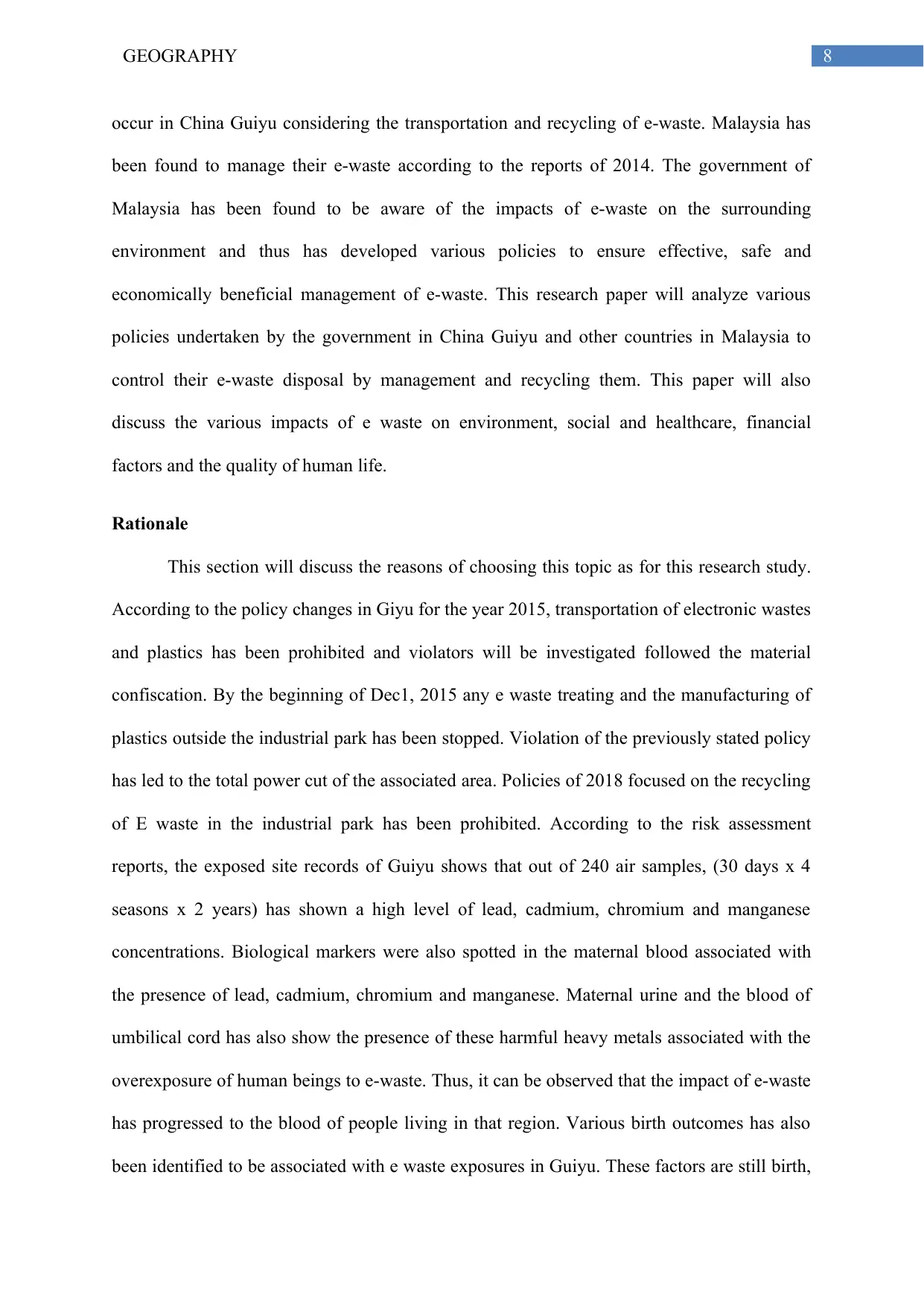
8GEOGRAPHY
occur in China Guiyu considering the transportation and recycling of e-waste. Malaysia has
been found to manage their e-waste according to the reports of 2014. The government of
Malaysia has been found to be aware of the impacts of e-waste on the surrounding
environment and thus has developed various policies to ensure effective, safe and
economically beneficial management of e-waste. This research paper will analyze various
policies undertaken by the government in China Guiyu and other countries in Malaysia to
control their e-waste disposal by management and recycling them. This paper will also
discuss the various impacts of e waste on environment, social and healthcare, financial
factors and the quality of human life.
Rationale
This section will discuss the reasons of choosing this topic as for this research study.
According to the policy changes in Giyu for the year 2015, transportation of electronic wastes
and plastics has been prohibited and violators will be investigated followed the material
confiscation. By the beginning of Dec1, 2015 any e waste treating and the manufacturing of
plastics outside the industrial park has been stopped. Violation of the previously stated policy
has led to the total power cut of the associated area. Policies of 2018 focused on the recycling
of E waste in the industrial park has been prohibited. According to the risk assessment
reports, the exposed site records of Guiyu shows that out of 240 air samples, (30 days x 4
seasons x 2 years) has shown a high level of lead, cadmium, chromium and manganese
concentrations. Biological markers were also spotted in the maternal blood associated with
the presence of lead, cadmium, chromium and manganese. Maternal urine and the blood of
umbilical cord has also show the presence of these harmful heavy metals associated with the
overexposure of human beings to e-waste. Thus, it can be observed that the impact of e-waste
has progressed to the blood of people living in that region. Various birth outcomes has also
been identified to be associated with e waste exposures in Guiyu. These factors are still birth,
occur in China Guiyu considering the transportation and recycling of e-waste. Malaysia has
been found to manage their e-waste according to the reports of 2014. The government of
Malaysia has been found to be aware of the impacts of e-waste on the surrounding
environment and thus has developed various policies to ensure effective, safe and
economically beneficial management of e-waste. This research paper will analyze various
policies undertaken by the government in China Guiyu and other countries in Malaysia to
control their e-waste disposal by management and recycling them. This paper will also
discuss the various impacts of e waste on environment, social and healthcare, financial
factors and the quality of human life.
Rationale
This section will discuss the reasons of choosing this topic as for this research study.
According to the policy changes in Giyu for the year 2015, transportation of electronic wastes
and plastics has been prohibited and violators will be investigated followed the material
confiscation. By the beginning of Dec1, 2015 any e waste treating and the manufacturing of
plastics outside the industrial park has been stopped. Violation of the previously stated policy
has led to the total power cut of the associated area. Policies of 2018 focused on the recycling
of E waste in the industrial park has been prohibited. According to the risk assessment
reports, the exposed site records of Guiyu shows that out of 240 air samples, (30 days x 4
seasons x 2 years) has shown a high level of lead, cadmium, chromium and manganese
concentrations. Biological markers were also spotted in the maternal blood associated with
the presence of lead, cadmium, chromium and manganese. Maternal urine and the blood of
umbilical cord has also show the presence of these harmful heavy metals associated with the
overexposure of human beings to e-waste. Thus, it can be observed that the impact of e-waste
has progressed to the blood of people living in that region. Various birth outcomes has also
been identified to be associated with e waste exposures in Guiyu. These factors are still birth,
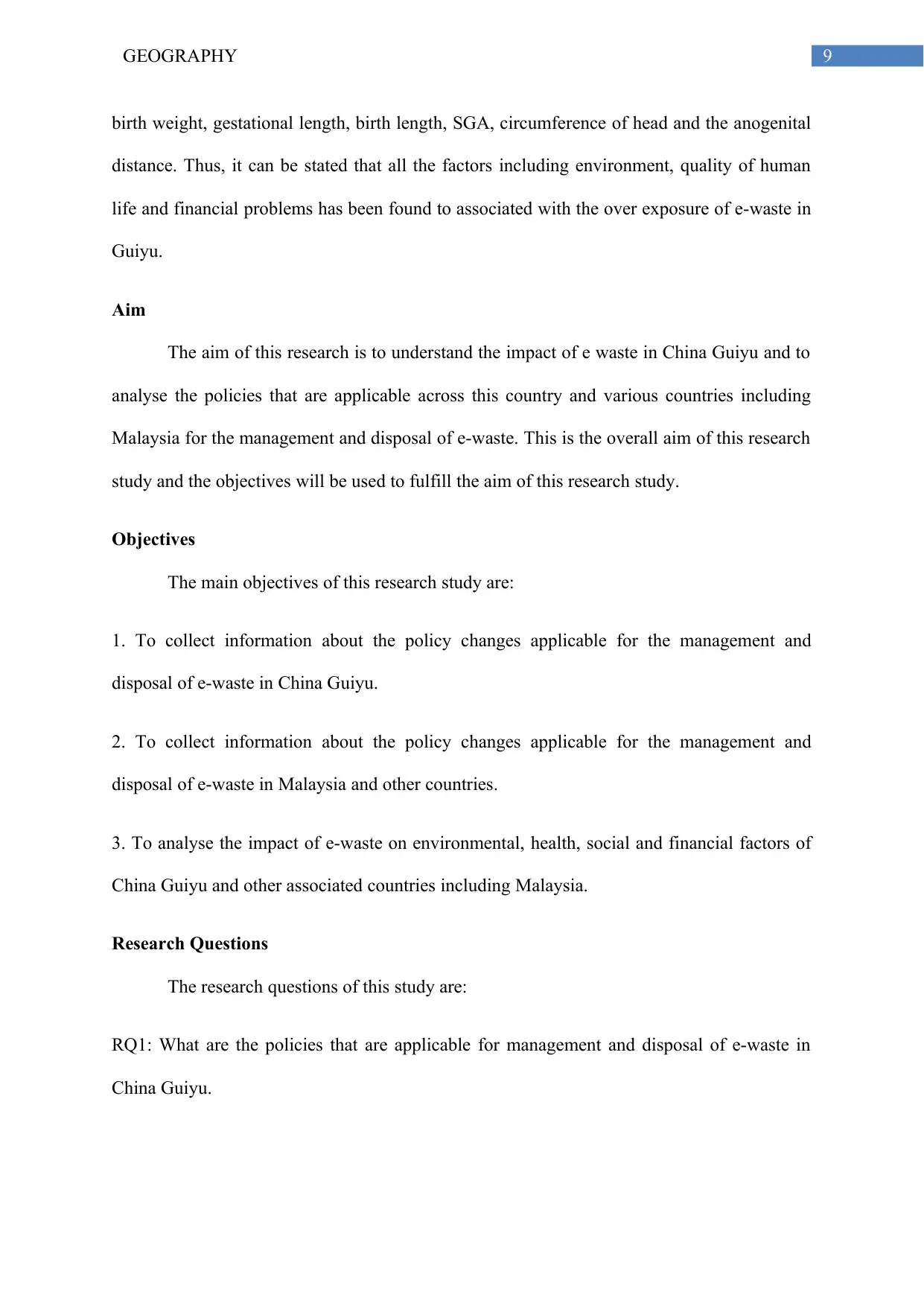
9GEOGRAPHY
birth weight, gestational length, birth length, SGA, circumference of head and the anogenital
distance. Thus, it can be stated that all the factors including environment, quality of human
life and financial problems has been found to associated with the over exposure of e-waste in
Guiyu.
Aim
The aim of this research is to understand the impact of e waste in China Guiyu and to
analyse the policies that are applicable across this country and various countries including
Malaysia for the management and disposal of e-waste. This is the overall aim of this research
study and the objectives will be used to fulfill the aim of this research study.
Objectives
The main objectives of this research study are:
1. To collect information about the policy changes applicable for the management and
disposal of e-waste in China Guiyu.
2. To collect information about the policy changes applicable for the management and
disposal of e-waste in Malaysia and other countries.
3. To analyse the impact of e-waste on environmental, health, social and financial factors of
China Guiyu and other associated countries including Malaysia.
Research Questions
The research questions of this study are:
RQ1: What are the policies that are applicable for management and disposal of e-waste in
China Guiyu.
birth weight, gestational length, birth length, SGA, circumference of head and the anogenital
distance. Thus, it can be stated that all the factors including environment, quality of human
life and financial problems has been found to associated with the over exposure of e-waste in
Guiyu.
Aim
The aim of this research is to understand the impact of e waste in China Guiyu and to
analyse the policies that are applicable across this country and various countries including
Malaysia for the management and disposal of e-waste. This is the overall aim of this research
study and the objectives will be used to fulfill the aim of this research study.
Objectives
The main objectives of this research study are:
1. To collect information about the policy changes applicable for the management and
disposal of e-waste in China Guiyu.
2. To collect information about the policy changes applicable for the management and
disposal of e-waste in Malaysia and other countries.
3. To analyse the impact of e-waste on environmental, health, social and financial factors of
China Guiyu and other associated countries including Malaysia.
Research Questions
The research questions of this study are:
RQ1: What are the policies that are applicable for management and disposal of e-waste in
China Guiyu.
⊘ This is a preview!⊘
Do you want full access?
Subscribe today to unlock all pages.

Trusted by 1+ million students worldwide
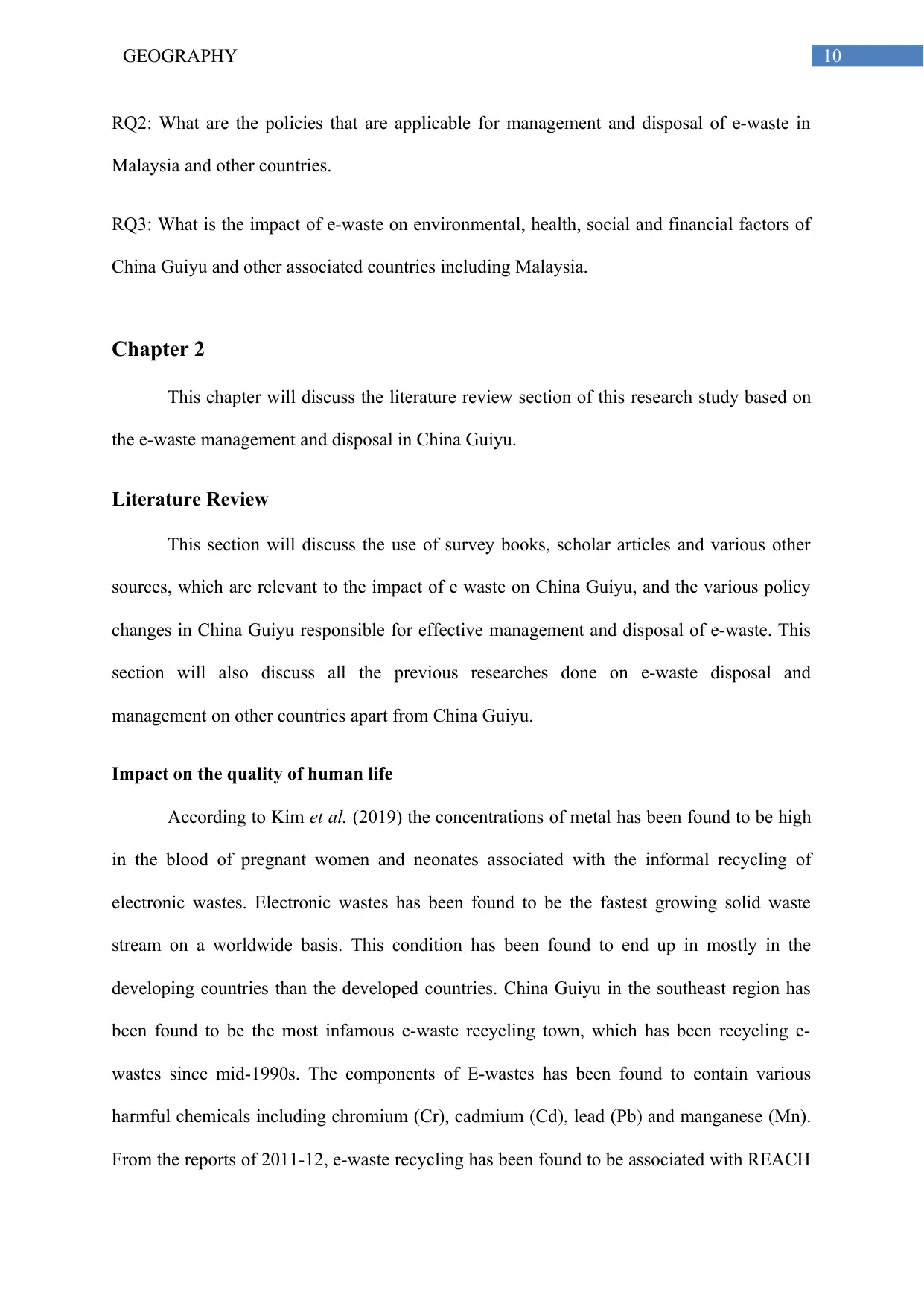
10GEOGRAPHY
RQ2: What are the policies that are applicable for management and disposal of e-waste in
Malaysia and other countries.
RQ3: What is the impact of e-waste on environmental, health, social and financial factors of
China Guiyu and other associated countries including Malaysia.
Chapter 2
This chapter will discuss the literature review section of this research study based on
the e-waste management and disposal in China Guiyu.
Literature Review
This section will discuss the use of survey books, scholar articles and various other
sources, which are relevant to the impact of e waste on China Guiyu, and the various policy
changes in China Guiyu responsible for effective management and disposal of e-waste. This
section will also discuss all the previous researches done on e-waste disposal and
management on other countries apart from China Guiyu.
Impact on the quality of human life
According to Kim et al. (2019) the concentrations of metal has been found to be high
in the blood of pregnant women and neonates associated with the informal recycling of
electronic wastes. Electronic wastes has been found to be the fastest growing solid waste
stream on a worldwide basis. This condition has been found to end up in mostly in the
developing countries than the developed countries. China Guiyu in the southeast region has
been found to be the most infamous e-waste recycling town, which has been recycling e-
wastes since mid-1990s. The components of E-wastes has been found to contain various
harmful chemicals including chromium (Cr), cadmium (Cd), lead (Pb) and manganese (Mn).
From the reports of 2011-12, e-waste recycling has been found to be associated with REACH
RQ2: What are the policies that are applicable for management and disposal of e-waste in
Malaysia and other countries.
RQ3: What is the impact of e-waste on environmental, health, social and financial factors of
China Guiyu and other associated countries including Malaysia.
Chapter 2
This chapter will discuss the literature review section of this research study based on
the e-waste management and disposal in China Guiyu.
Literature Review
This section will discuss the use of survey books, scholar articles and various other
sources, which are relevant to the impact of e waste on China Guiyu, and the various policy
changes in China Guiyu responsible for effective management and disposal of e-waste. This
section will also discuss all the previous researches done on e-waste disposal and
management on other countries apart from China Guiyu.
Impact on the quality of human life
According to Kim et al. (2019) the concentrations of metal has been found to be high
in the blood of pregnant women and neonates associated with the informal recycling of
electronic wastes. Electronic wastes has been found to be the fastest growing solid waste
stream on a worldwide basis. This condition has been found to end up in mostly in the
developing countries than the developed countries. China Guiyu in the southeast region has
been found to be the most infamous e-waste recycling town, which has been recycling e-
wastes since mid-1990s. The components of E-wastes has been found to contain various
harmful chemicals including chromium (Cr), cadmium (Cd), lead (Pb) and manganese (Mn).
From the reports of 2011-12, e-waste recycling has been found to be associated with REACH
Paraphrase This Document
Need a fresh take? Get an instant paraphrase of this document with our AI Paraphraser
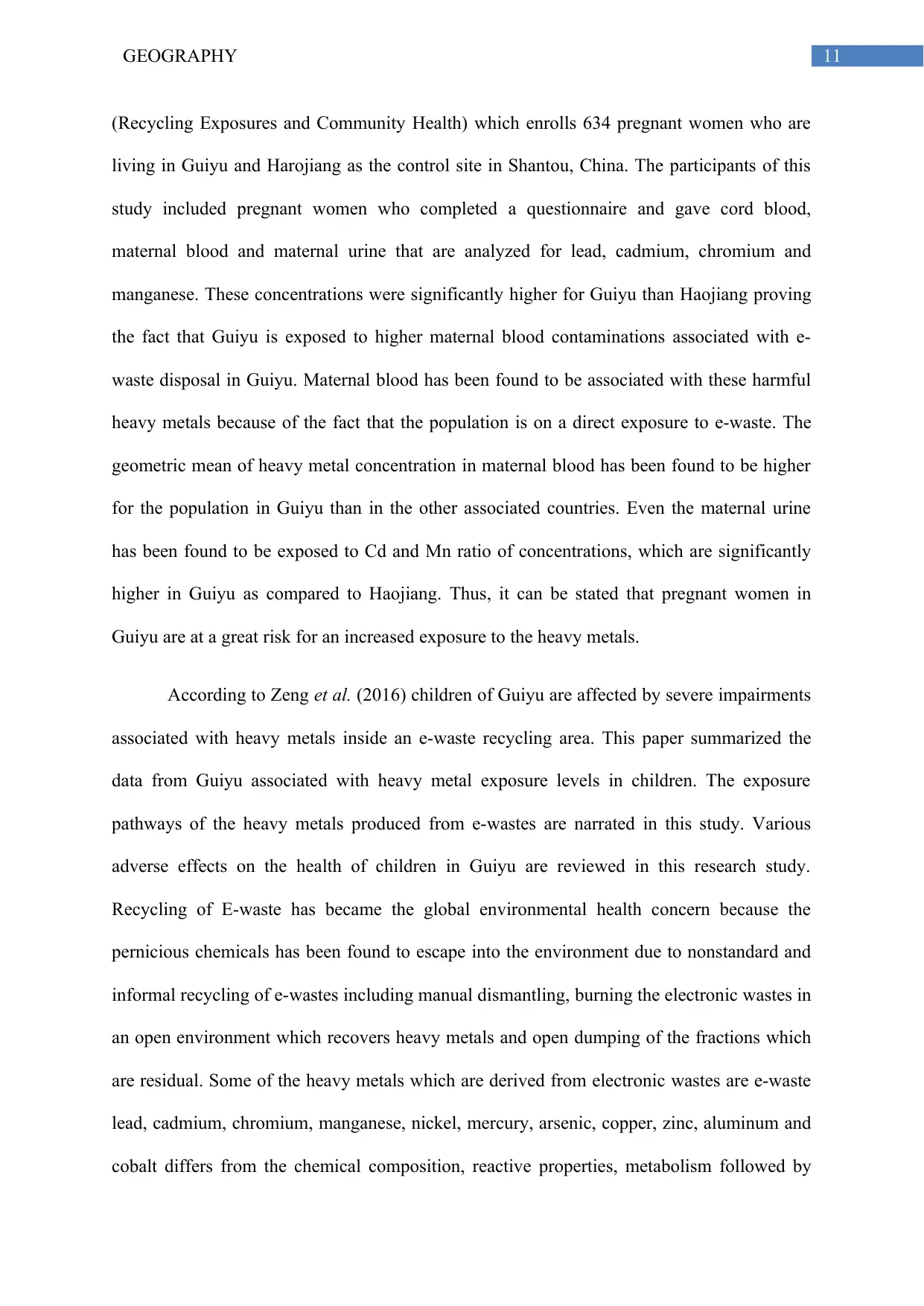
11GEOGRAPHY
(Recycling Exposures and Community Health) which enrolls 634 pregnant women who are
living in Guiyu and Harojiang as the control site in Shantou, China. The participants of this
study included pregnant women who completed a questionnaire and gave cord blood,
maternal blood and maternal urine that are analyzed for lead, cadmium, chromium and
manganese. These concentrations were significantly higher for Guiyu than Haojiang proving
the fact that Guiyu is exposed to higher maternal blood contaminations associated with e-
waste disposal in Guiyu. Maternal blood has been found to be associated with these harmful
heavy metals because of the fact that the population is on a direct exposure to e-waste. The
geometric mean of heavy metal concentration in maternal blood has been found to be higher
for the population in Guiyu than in the other associated countries. Even the maternal urine
has been found to be exposed to Cd and Mn ratio of concentrations, which are significantly
higher in Guiyu as compared to Haojiang. Thus, it can be stated that pregnant women in
Guiyu are at a great risk for an increased exposure to the heavy metals.
According to Zeng et al. (2016) children of Guiyu are affected by severe impairments
associated with heavy metals inside an e-waste recycling area. This paper summarized the
data from Guiyu associated with heavy metal exposure levels in children. The exposure
pathways of the heavy metals produced from e-wastes are narrated in this study. Various
adverse effects on the health of children in Guiyu are reviewed in this research study.
Recycling of E-waste has became the global environmental health concern because the
pernicious chemicals has been found to escape into the environment due to nonstandard and
informal recycling of e-wastes including manual dismantling, burning the electronic wastes in
an open environment which recovers heavy metals and open dumping of the fractions which
are residual. Some of the heavy metals which are derived from electronic wastes are e-waste
lead, cadmium, chromium, manganese, nickel, mercury, arsenic, copper, zinc, aluminum and
cobalt differs from the chemical composition, reactive properties, metabolism followed by
(Recycling Exposures and Community Health) which enrolls 634 pregnant women who are
living in Guiyu and Harojiang as the control site in Shantou, China. The participants of this
study included pregnant women who completed a questionnaire and gave cord blood,
maternal blood and maternal urine that are analyzed for lead, cadmium, chromium and
manganese. These concentrations were significantly higher for Guiyu than Haojiang proving
the fact that Guiyu is exposed to higher maternal blood contaminations associated with e-
waste disposal in Guiyu. Maternal blood has been found to be associated with these harmful
heavy metals because of the fact that the population is on a direct exposure to e-waste. The
geometric mean of heavy metal concentration in maternal blood has been found to be higher
for the population in Guiyu than in the other associated countries. Even the maternal urine
has been found to be exposed to Cd and Mn ratio of concentrations, which are significantly
higher in Guiyu as compared to Haojiang. Thus, it can be stated that pregnant women in
Guiyu are at a great risk for an increased exposure to the heavy metals.
According to Zeng et al. (2016) children of Guiyu are affected by severe impairments
associated with heavy metals inside an e-waste recycling area. This paper summarized the
data from Guiyu associated with heavy metal exposure levels in children. The exposure
pathways of the heavy metals produced from e-wastes are narrated in this study. Various
adverse effects on the health of children in Guiyu are reviewed in this research study.
Recycling of E-waste has became the global environmental health concern because the
pernicious chemicals has been found to escape into the environment due to nonstandard and
informal recycling of e-wastes including manual dismantling, burning the electronic wastes in
an open environment which recovers heavy metals and open dumping of the fractions which
are residual. Some of the heavy metals which are derived from electronic wastes are e-waste
lead, cadmium, chromium, manganese, nickel, mercury, arsenic, copper, zinc, aluminum and
cobalt differs from the chemical composition, reactive properties, metabolism followed by
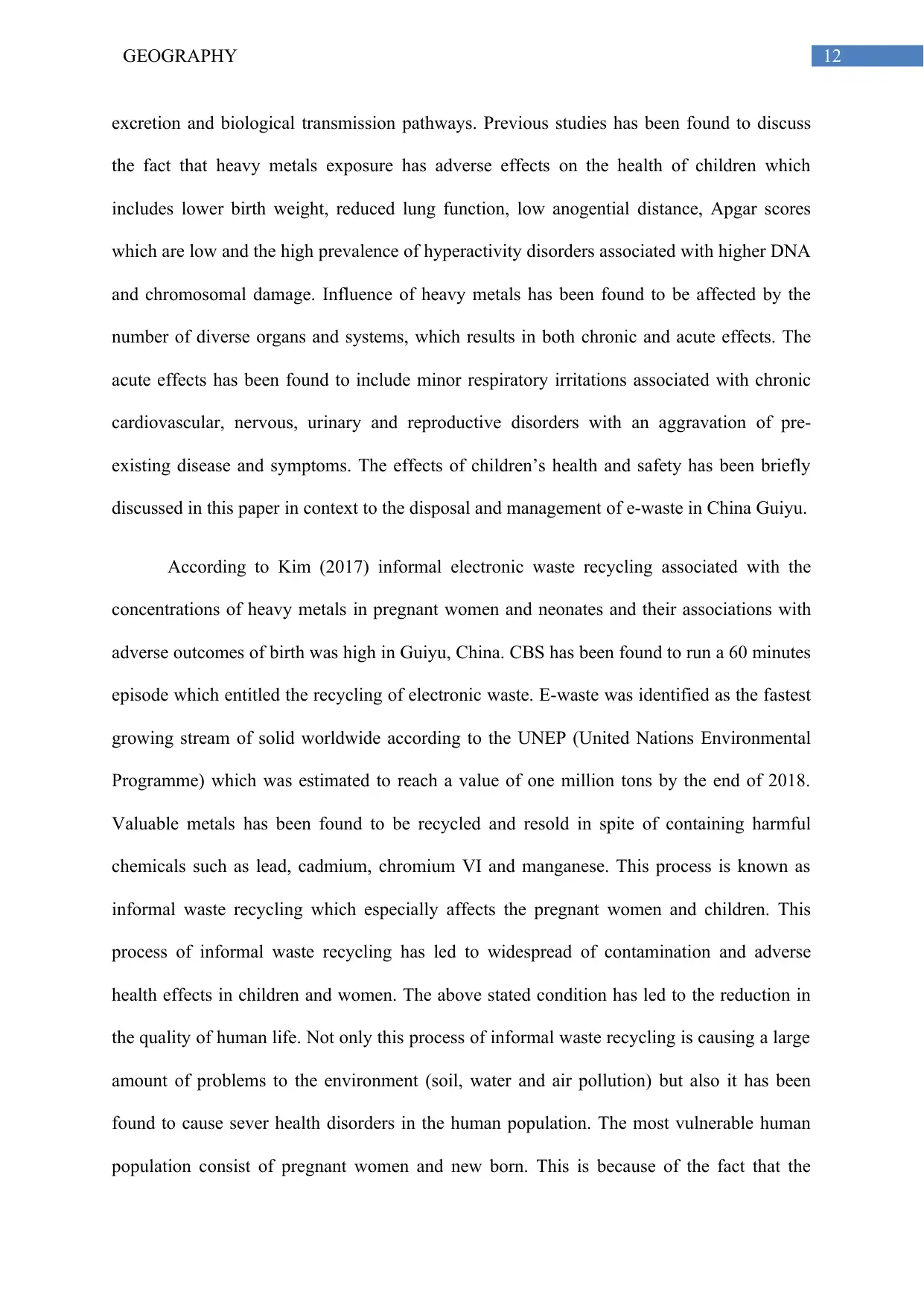
12GEOGRAPHY
excretion and biological transmission pathways. Previous studies has been found to discuss
the fact that heavy metals exposure has adverse effects on the health of children which
includes lower birth weight, reduced lung function, low anogential distance, Apgar scores
which are low and the high prevalence of hyperactivity disorders associated with higher DNA
and chromosomal damage. Influence of heavy metals has been found to be affected by the
number of diverse organs and systems, which results in both chronic and acute effects. The
acute effects has been found to include minor respiratory irritations associated with chronic
cardiovascular, nervous, urinary and reproductive disorders with an aggravation of pre-
existing disease and symptoms. The effects of children’s health and safety has been briefly
discussed in this paper in context to the disposal and management of e-waste in China Guiyu.
According to Kim (2017) informal electronic waste recycling associated with the
concentrations of heavy metals in pregnant women and neonates and their associations with
adverse outcomes of birth was high in Guiyu, China. CBS has been found to run a 60 minutes
episode which entitled the recycling of electronic waste. E-waste was identified as the fastest
growing stream of solid worldwide according to the UNEP (United Nations Environmental
Programme) which was estimated to reach a value of one million tons by the end of 2018.
Valuable metals has been found to be recycled and resold in spite of containing harmful
chemicals such as lead, cadmium, chromium VI and manganese. This process is known as
informal waste recycling which especially affects the pregnant women and children. This
process of informal waste recycling has led to widespread of contamination and adverse
health effects in children and women. The above stated condition has led to the reduction in
the quality of human life. Not only this process of informal waste recycling is causing a large
amount of problems to the environment (soil, water and air pollution) but also it has been
found to cause sever health disorders in the human population. The most vulnerable human
population consist of pregnant women and new born. This is because of the fact that the
excretion and biological transmission pathways. Previous studies has been found to discuss
the fact that heavy metals exposure has adverse effects on the health of children which
includes lower birth weight, reduced lung function, low anogential distance, Apgar scores
which are low and the high prevalence of hyperactivity disorders associated with higher DNA
and chromosomal damage. Influence of heavy metals has been found to be affected by the
number of diverse organs and systems, which results in both chronic and acute effects. The
acute effects has been found to include minor respiratory irritations associated with chronic
cardiovascular, nervous, urinary and reproductive disorders with an aggravation of pre-
existing disease and symptoms. The effects of children’s health and safety has been briefly
discussed in this paper in context to the disposal and management of e-waste in China Guiyu.
According to Kim (2017) informal electronic waste recycling associated with the
concentrations of heavy metals in pregnant women and neonates and their associations with
adverse outcomes of birth was high in Guiyu, China. CBS has been found to run a 60 minutes
episode which entitled the recycling of electronic waste. E-waste was identified as the fastest
growing stream of solid worldwide according to the UNEP (United Nations Environmental
Programme) which was estimated to reach a value of one million tons by the end of 2018.
Valuable metals has been found to be recycled and resold in spite of containing harmful
chemicals such as lead, cadmium, chromium VI and manganese. This process is known as
informal waste recycling which especially affects the pregnant women and children. This
process of informal waste recycling has led to widespread of contamination and adverse
health effects in children and women. The above stated condition has led to the reduction in
the quality of human life. Not only this process of informal waste recycling is causing a large
amount of problems to the environment (soil, water and air pollution) but also it has been
found to cause sever health disorders in the human population. The most vulnerable human
population consist of pregnant women and new born. This is because of the fact that the
⊘ This is a preview!⊘
Do you want full access?
Subscribe today to unlock all pages.

Trusted by 1+ million students worldwide
1 out of 55
Related Documents
Your All-in-One AI-Powered Toolkit for Academic Success.
+13062052269
info@desklib.com
Available 24*7 on WhatsApp / Email
![[object Object]](/_next/static/media/star-bottom.7253800d.svg)
Unlock your academic potential
Copyright © 2020–2025 A2Z Services. All Rights Reserved. Developed and managed by ZUCOL.





